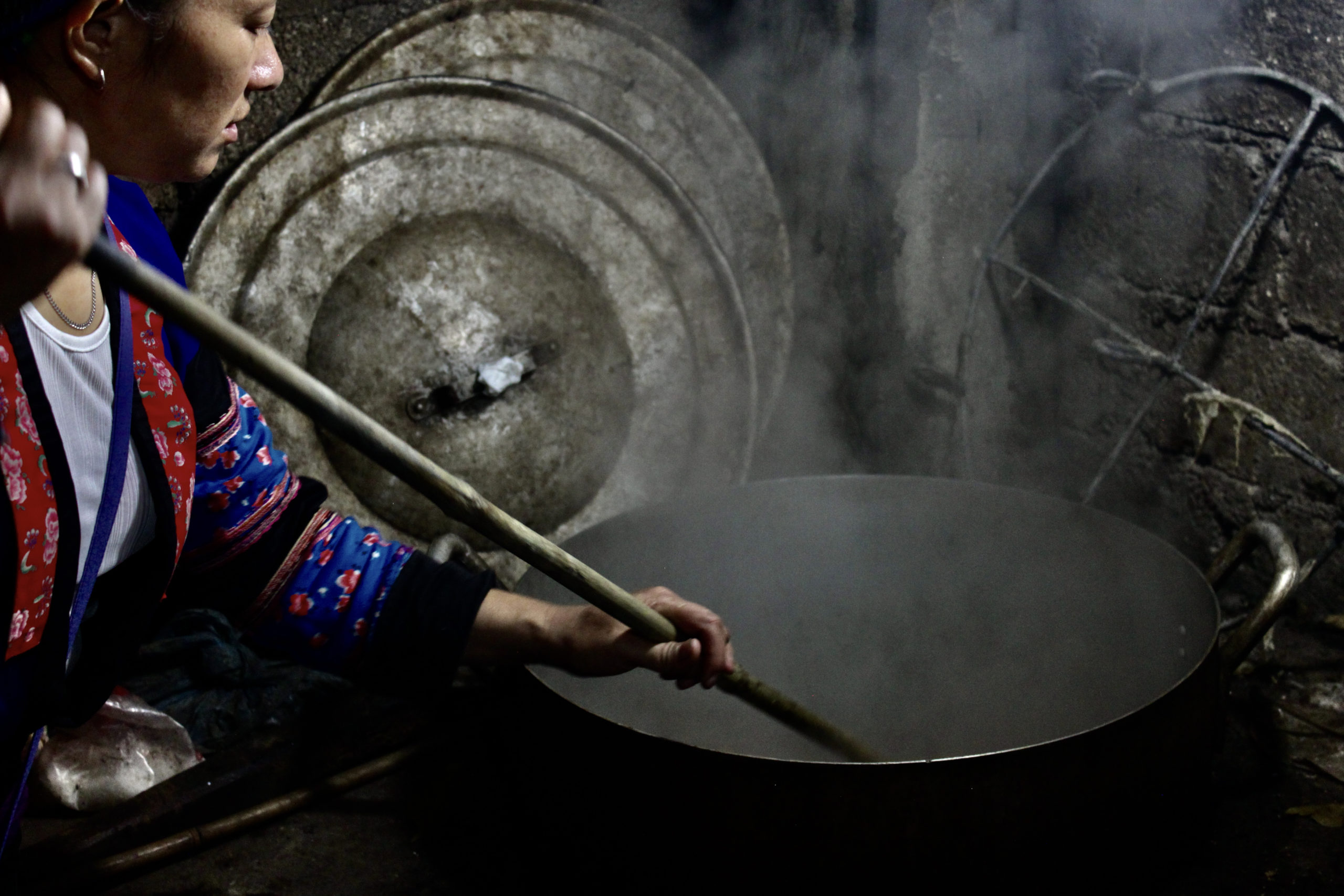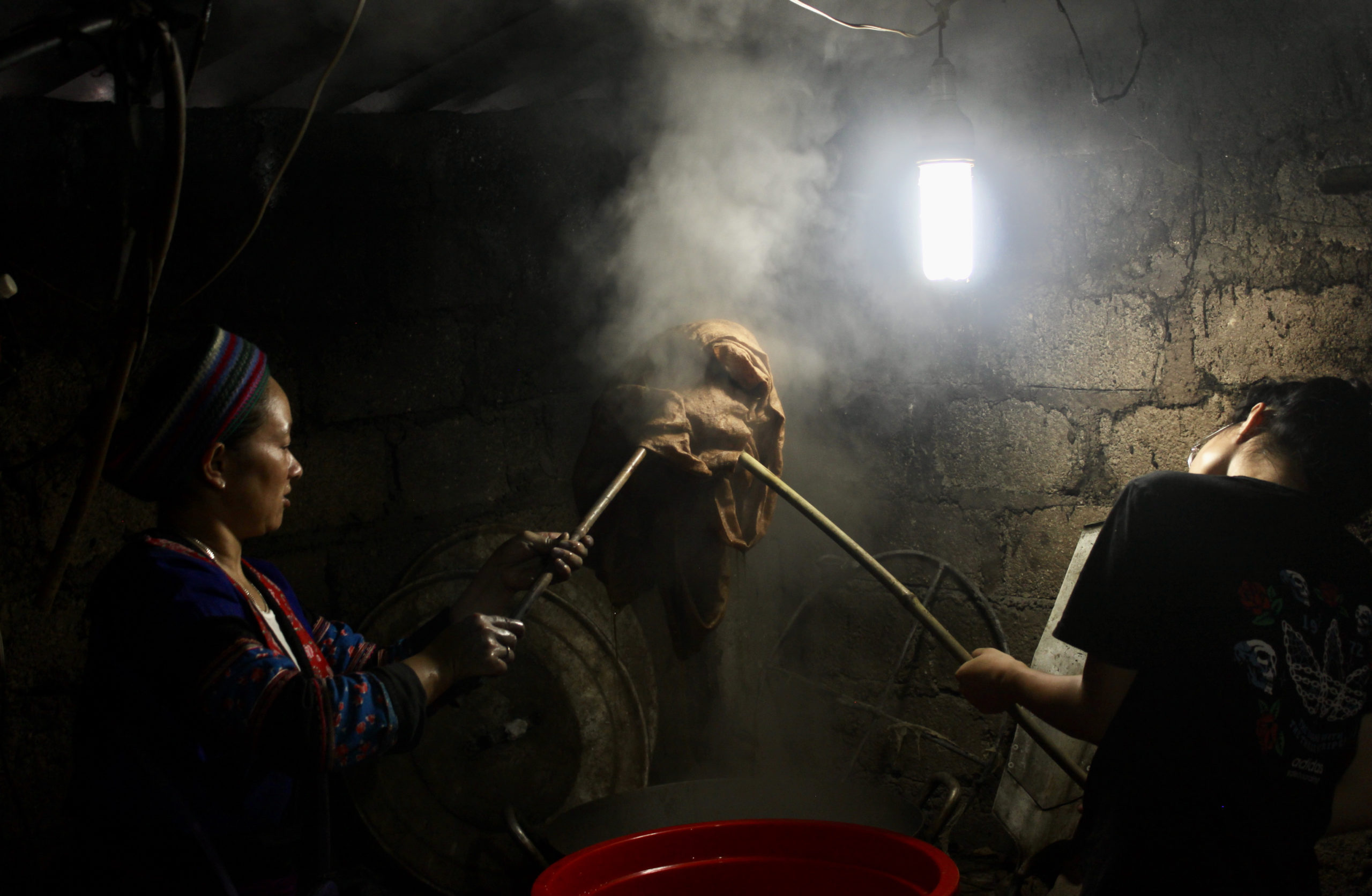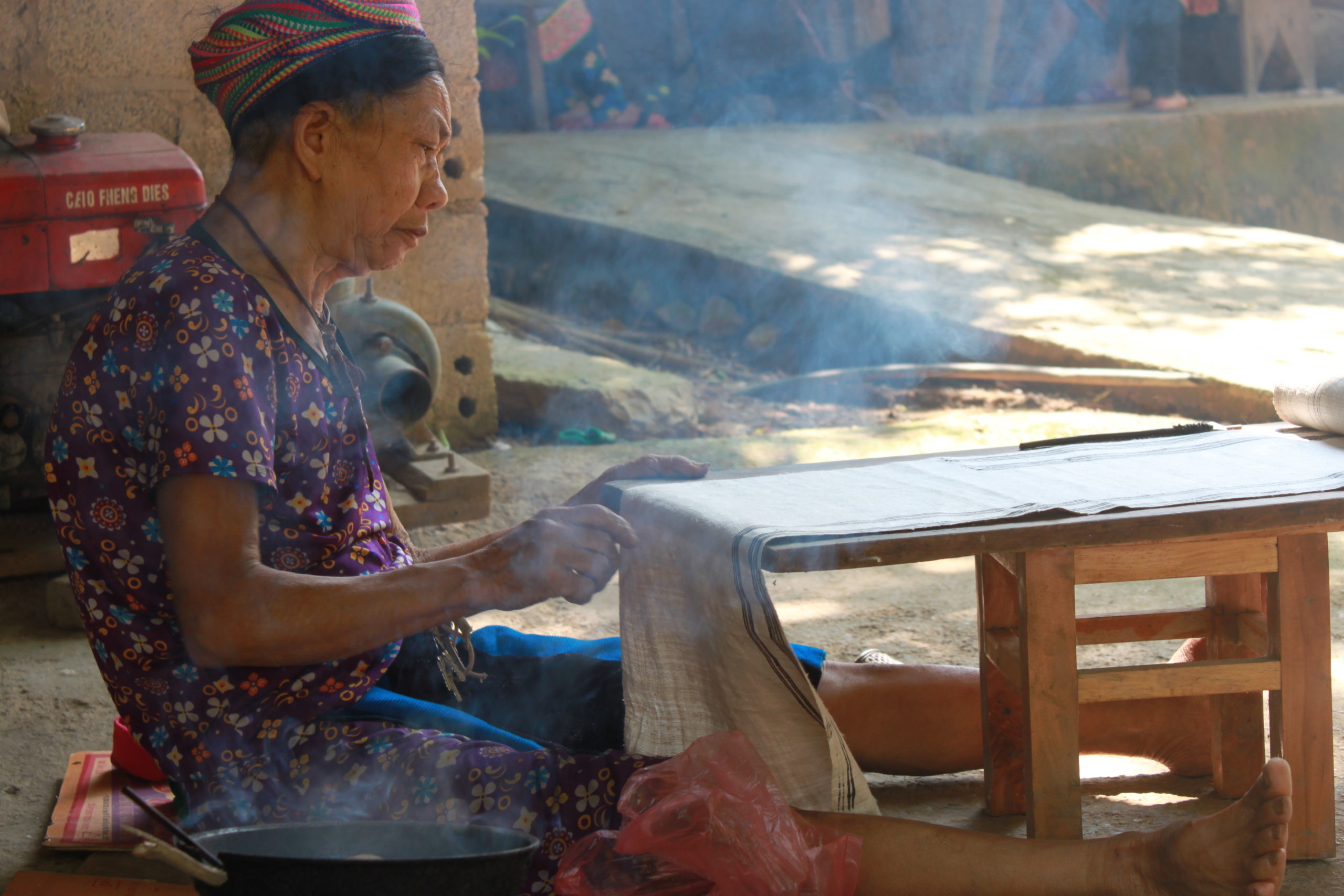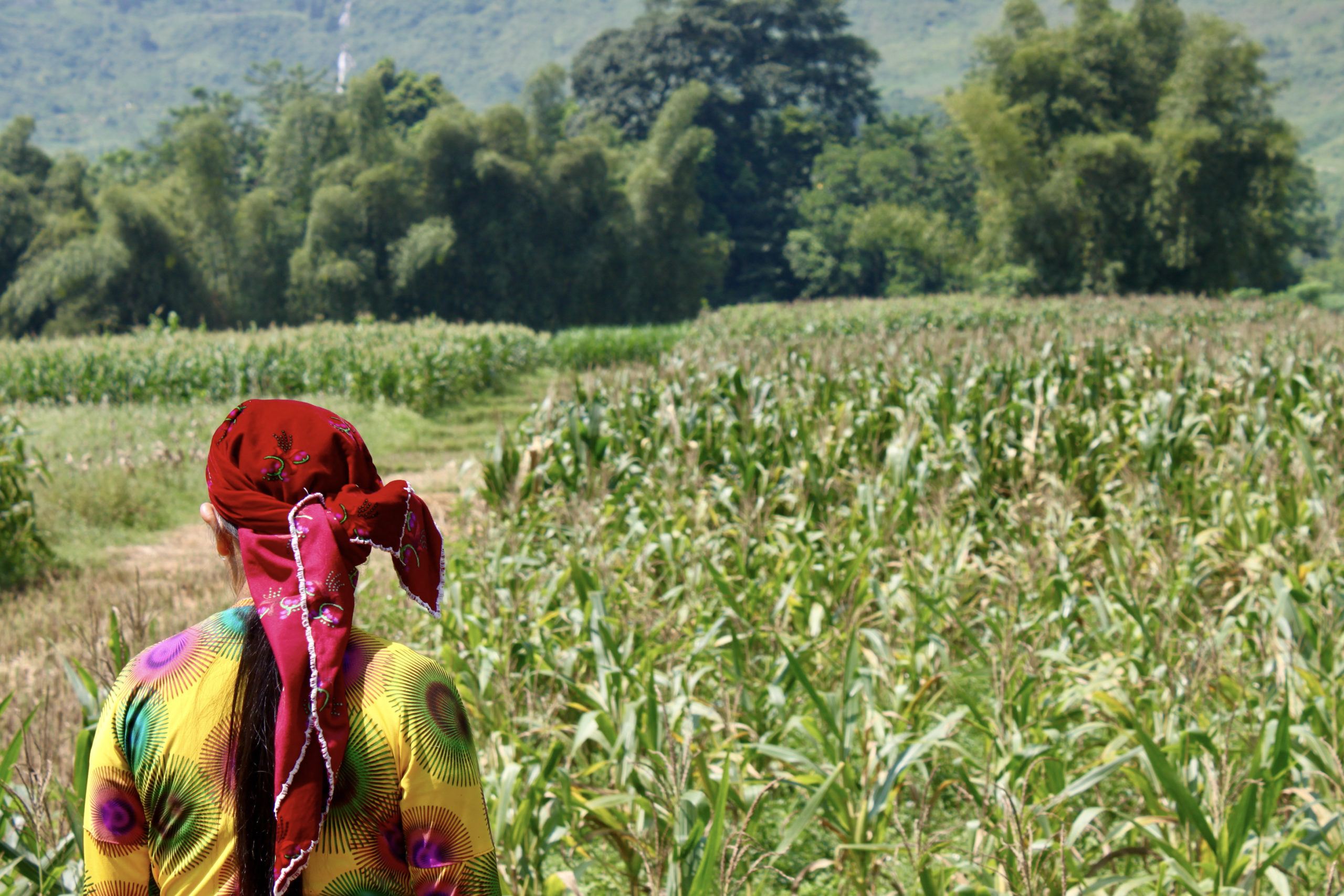In Ha Giang, you wind through mountain paths, look over cliffs into thick rivers of fog, and feel in total isolation from the outside world. It seems impossible to reach, but you do, packed in with 40 other sweating, contorted riders on a bus built for 20.
I was here to visit Mi, a traditional Hmong artisan, in her mountain home. She was wrapping up a cameo in a Netflix pilot on traditional craftsmanship in Vietnam. It was only the latest in a slew of related media visits. As with the many tourists who visit Mi’s home in Ha Giang, there was a strained focus on the “traditional” element of her craft.
One cameraman followed Mi’s husband down to their fields, where he began to thread the harvest through a dilapidated rice huller. The spectacle raised a chorus of laughter and surprised cheers from the group of female farm workers. Shaded beneath an oversized Coca Cola umbrella, they had been busily toiling away at the very same task before the arrival of the camera crew.
The focus on her husband felt like a metaphor for Mi and her group of female workers, whose attempts to move past gender stereotypes and gain more status in their communities are often quelled by mawkish traditions. But in a push for self-determination, Mi and the rest of her employees are tapping into tradition and actively moving away from backbreaking agricultural work.
In recent years, traditional crafts from Vietnam’s minority cultures have seen a resurgence in demand at home and abroad – in part a reaction to a growing concern over the fast-fashion industry, where human rights abuses and environmental degradation are rife. Female-owned businesses like Mi’s, or more high end fashion like Hanoi’s Kilomet109, are just two attempting to empower female minority workers to earn their own income and stay in their hometowns, rather than travelling over the nearby border to China for work.
“I used to live through difficult times. Other women went to China to look for jobs, but leaving is so difficult,” said Mi. “They would get beaten by their husbands when they come home, and then they would stop them going back to China.”
A few years ago, using the traditional hemp weaving and indigo dyeing techniques taught to her by her step-mother, Mi began producing long strips of delicately crafted hemp, about a foot wide, and covering storey after storey of tall buildings in length. It’s detailed, covering a vast array of patterns. Selling these woven fabrics to passers-by allowed her to spend more time with her family and community, generating much-needed employment opportunities for the other women in her village.
“That is one of the reasons that I try to grow my business,” Mi explained. Her textile business currently employs 14 local women and supplies to Hanoi-based businesses like Touched. “To help the women in my village find work.”


Mi as a part of Vietnam’s Hmong minority group. Described throughout history as ‘people who [dwell] among the clouds and mist,’ the Hmong have called these mountainous highlands home since the end of the 18th century.
They are just one of Vietnam’s 54 ethnic minority groups, comprising about 8 million of the nation’s 95 million total citizens. Minority artisans from rural Hmong villages up in these remote mountainous landscapes are producing complex hemp and indigo-dyed handicrafts, spinning and weaving their fibrous materials with techniques developed over several thousand years.
Recently, however, these items have been gathering attention from further down the rocky roads, and are being sold in Hanoi, the capital city, in high-end boutiques, and even further, as far as Bristol in the west of England.
As with any craft tradition, hemp handicrafts were once closely linked to indiginous lifestyles. Whenever a family would settle somewhere new, the women of the house would hand-carry seeds of hemp to the new location, preparing the ground for a new crop on day one.
I currently have about 14 people working for me, though most of them are my family. But I want to try and grow to 16. There are people in the village who need help, some have difficult living situations, and I want to support them
But these days, minority farmers in villages like Mi’s focus primarily on growing more intensive cash-crops like corn and rice, leaving hemp cultivation to a few larger factories. Fields once used for growing hemp and indigo plants have transformed into cornfields and pasture-land for grazing livestock. As a result, the Hmong’s hemp cultivating traditions and handicraft arts have gradually begun to fade.
But a few years ago Mi began to notice the potential for this fading tradition, and asked her mother-in-law to teach her the skills required to weave her own. From there, she began to head down from the mountain, setting up her stacks of deep blue indigo dyed fabrics and hawking her handmade goods at craft fairs around the capital Hanoi.
Since then, Mi has gradually garnered the support of organisations like the British Council’s Crafting Future programme, which aims to encourage sustainable livelihoods and improve the well-being of women and girls in rural communities.
“I currently have about 14 people working for me, though most of them are my family. But I want to try and grow to 16.” said Mi. “There are people in the village who need help, some have difficult living situations, and I want to support them.”
When asked whether she is worried about market demands for fast-fashion jeopardising traditional Hmong culture, Mi answered with a blunt, unequivocal, no. For Mi, the textile business isn’t necessarily about preserving tradition, it’s about creating a sustainable livelihood for her family.
Rather than traditional hemp outfits, Mi’s husband and sons wear factory-made t-shirts and shorts. As she prepares for her day of interacting with tourists, she quickly grabs her traditional garb.
“I love the pattern on that dress,” one tourist tells her as we sit in the back of her wooden home, sipping tea. Mi laughs. “Thank you,” she responds, “it’s from a factory in China”.

Chee, one of Mi’s employees, is beating on a large, sopping wet bundle of hemp-turned fabric outside of her home, casting a thin stream of blue indigo dye streaming slowly down the road.
“I live just behind Mi’s house with my husband,” Chee explains. “I’ve been working with Mi since 2009, though I only work part-time. Still, for the days I work I get 150K VND ($6.50 USD).”
Chee said that if it weren’t for Mi’s textile business, she’d be working in a factory in China herself. She’d done that work in the past, but struggled to understand the sewing machines.
“The work is hard,” Chee says. “They make you work really long hours, and there’s always a language barrier because I can’t speak Chinese. You also have to work away from your family and you can’t look after your children.”
Precarious financial circumstances have driven women in many ethnic minority households to travel abroad seeking work. In 2016 alone, an estimated 200,000 people left Vietnam by irregular means to look for seasonal employment, mostly in China and other bordering countries.
Though Chee admits that the money was better in China, that wasn’t her only consideration. To get there, women face dangerous backroads, risking human trafficking rackets that could see them sold into coerced marriages or brothel work, places where cruel conditions are standard.
“I could earn around 11 million a month [in a factory in China], but I wasn’t happy,” she said. “Working here gives me the chance to be around my children.”
As Vietnam’s economy booms, with high-rises shooting up like bean sprouts in urban areas, wealth continues to grow primarily for the majority Kinh ethnic group. Meanwhile, many minority communities remain dependent on subsistence level farming just to get by.
The agricultural sector is slow-growing in Vietnam, especially when compared to the rest of the nation’s skyrocketing industries. With the Kinh majority investing heavily in lucrative emerging markets and minority groups largely stuck in agricultural production, a widening income gap has emerged. Though they make up less than 15% of Vietnam’s total population, ethnic minorities constitute 47% of the nation’s poor, with 66.3% living well below the poverty line.
Thao Vu, founder of Kilomet109, a high-end fashion brand made up of local artisans, found that giving new perspectives on traditional textiles empowered the artisan women that she works with to view their work with a new, creative eye.
“When I started working with them they would look at their tradition as something to be sold in a souvenir shop, or fair trade market, or working with NGOs, and that’s it. Nothing more than that,” Thao told the Globe. “So, when I started working with them, I explained that I wanted to create something contemporary.”
Mixing up tradition as Thao does isn’t always easy. She found that many minority artisans were often sceptical about her plans, and when she began playing with different shades of indigo dye, creating a stone bluish grey which the community hadn’t seen before, she received pushback.
It wasn’t until after Thao took the material home and turned it into a skirt that the artisans began to appreciate how their work, passed down from generation to generation, could be adapted to modern tastes.
“They looked at it and said, is this our fabric? Is this from my mum? It has changed on so many levels!”

Thao works with multiple ethnic minority groups around the country, and just like Mi, helps them transition away from farming into more financially productive sectors.
“They’ve been able to fix their houses, even buying second homes, buying more cows and more water buffalo,” Thao said.
However, according to Thao, it’s not just the financial gains that are benefiting these minority groups, but the ability to keep their traditional crafts alive and relevant in a changing modern world. She explains that, when she first met them some 10 years ago, many of these cultures were on the verge of losing their communal handicraft traditions.
As international interest grows, with a slow but steady move away from farming and back towards traditional crafts, it seems that a resurgence of minority textile traditions could be on the way.
Like Thao’s artisans, Mi has been busy growing fields of hemp. For every corn yield, she’ll follow it up with a hemp crop. These plants improve the environment, increase biodiversity and enhance soil health by shedding weeds and reducing the need for herbicides. What’s more, they’re helping to keep minority handicraft traditions alive.
Mi and Thao may have divergent motivations for their businesses – one a pragmatic focus on alleviating poverty, the other a quest to preserve indigenous culture. But their efforts ultimately achieve the same results: a better future for ethnic minorities in rural areas, environmentally sustainable fashion that allows women to stay with their families and a way of keeping traditional textiles alive.
It seems that now, Mi is doing what her ancestors did. Taking that hemp seed to a new location, preparing the ground, and watching a business shoot up.
“If I can create jobs here,” said Mi. “It will give everyone the chance at a better life.”


